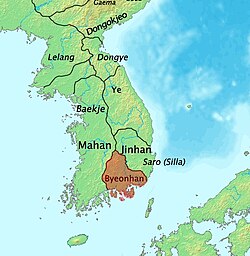
Back كونفدرالية بيونهان Arabic Byeonhan Catalan Byeonhan Danish Byeonhan German Byeonhan Spanish متحدین بایونهان Persian Byeonhan French Konfederasi Byeonhan ID Confederazione di Byeonhan Italian 弁韓 Japanese
Byeonhan confederacy 변한 (弁韓) | |||||||||
|---|---|---|---|---|---|---|---|---|---|
| 194 BCE–42 CE | |||||||||
 The Korean peninsula in the 1st century, Byeonhan shaded in red. | |||||||||
| Common languages | Han | ||||||||
| Religion | Shamanism | ||||||||
| Government | Confederacy | ||||||||
| Historical era | Ancient | ||||||||
• Establishment | 194 BCE | ||||||||
• Transition to the Gaya confederacy. | 42 CE | ||||||||
| |||||||||
| Today part of | South Korea | ||||||||
| Byeonhan confederacy | |
| Hangul | 변한 / 변진 |
|---|---|
| Hanja | 弁韓 / 弁辰 |
| Revised Romanization | Byeonhan / Byeonjin |
| McCune–Reischauer | Pyŏnhan / Pyŏnjin |
| History of Korea |
|---|
 |
| Timeline |
|
|

Byeonhan (Korean: 변한; Hanja: 弁韓; RR: Byeonhan, Korean pronunciation: [pjʌn.ɦan]), also known as Byeonjin,[1] (변진; 弁辰; Byeonjin, Korean pronunciation: [pjʌn.dʑin]) was a loose confederacy of chiefdoms that existed from around the beginning of the Common Era to the 4th century in the southern Korean peninsula. Byeonhan was one of the Samhan (or "Three Hans"), along with Mahan and Jinhan.[2]
- ^ Huiyi, Yi; Songsu, Park; Naehyon, Yun (2005). New history of Korea. Seoul: Jimundang. p. 136. ISBN 8988095855.
- ^ Ebrey, Patricia; Walthall, Anne (2013-01-01). Pre-Modern East Asia: A Cultural, Social, and Political History, Volume I: To 1800. Cengage Learning. p. 101. ISBN 978-1133606512.